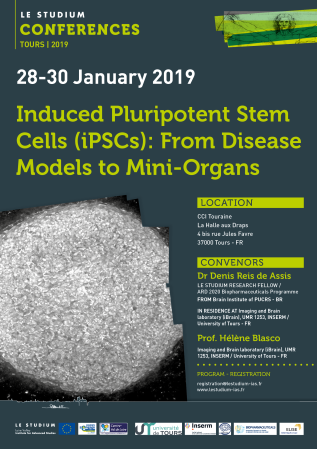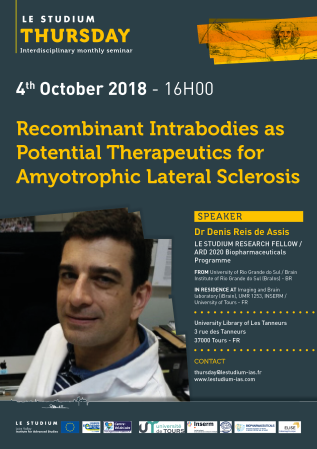Dr Denis Reis de Assis

Établissement d'origine
Institut du Cerveau de PUCRS - BR
Laboratoire d'accueil
Imagerie et Cerveau (IC), INSERM / Université de Tours - FR
Hôte Scientifique
Prof. Hélène Blasco
Projet
Recombinant Intrabodies as Molecular Tools and Potential Therapeutics for Amyotrophic Lateral Sclerosis
Amyotrophic lateral sclerosis (ALS) is a rapidly progressive motor neuron disease, invariably fatal and lacking effective treatments. The presence of aggregates of hyper-phosphorylated TAR DNA-binding protein 43 (TDP-43) in the cytosol of affected motor neurons is present in most of ALS patients and is considered as a hallmark of the disease. Several cellular and in vivo models of TDP-43 proteinopathy have shown a correlation between the presence of cytosolic TDP-43 aggregates and cellular toxicity. Here, we intend to validate cellular models of TDP-43 proteinopathy based on fibroblasts from ALS patients and the motor neuron line NSC-34 transfected with a plasmid expressing TDP-43. We will test whether these cells develop cytosolic TDP-43 aggregates, as well as identify the most remarkable alterations among parameters of metabolomic analysis, oxidative stress, mitochondrial bioenergetics,), and cellular viability. Next, we will submit the cell models of TDP-43 proteinopathy to novel therapy based on anti-TDP-43 intrabodies as an attempt to suppress the formation the TDP-43 aggregates and to rescue the selected markers.
Publications
The Debated Toxic Role of Aggregated TDP-43 in Amyotrophic Lateral Sclerosis: A Resolution in Sight?
Transactive Response DNA-Binding Protein-43 (TDP-43) is an RNA/DNA binding protein that forms phosphorylated and ubiquitinated aggregates in the cytoplasm of motor neurons in Amyotrophic Lateral Sclerosis (ALS), which is a hallmark of this disease. ALS is a neurodegenerative condition affecting the upper and lower motor neurons. Even though the aggregative property of TDP-43 is considered a cornerstone of ALS, there has been major controversy regarding the functional link between TDP-43 aggregates and cell death. In this review, we attempt to reconcile the current literature surrounding this debate by discussing the results and limitations of the published data relating TDP-43 aggregates to cytotoxicity, as well as therapeutic perspectives of TDP-43 aggregate clearance. We point out key data suggesting that the formation of TDP-43 aggregates and the capacity to self-template and propagate among cells as a “prion-like” protein, another pathological property of TDP-43 aggregates, are a significant cause of motor neuronal death. We discuss the disparities among the various studies, particularly with respect to the type of models and the different forms of TDP-43 utilized to evaluate cellular toxicity. We also examine how these disparities can interfere with the interpretation of the results pertaining to a direct toxic effect of TDP-43 aggregates. Furthermore, we present perspectives for improving models in order to better uncover the toxic role of aggregated TDP-43. Finally, we review the recent studies on the enhancement of the cellular clearance mechanisms of autophagy, the ubiquitin proteasome system, and endocytosis in an attempt to counteract TDP-43 aggregation-induced toxicity. Altogether, the data available so far encourage us to suggest that the cytoplasmic aggregation of TDP-43 is key for the neurodegeneration observed in motor neurons in ALS patients. The corresponding findings provide novel avenues toward early therapeutic interventions and clinical outcomes for ALS management.
Final reports
Amyotrophic lateral sclerosis (ALS) is a neurodegenerative disease that has no diagnostic marker, prognosis, nor an effective treatment. Numerous physiopathological mechanisms have been described for this disease, such as glutamatergic excitotoxicity, oxidative stress, and the accumulation of protein aggregates in cells of the central nervous system, in particular the aggregation of cytoplasmic TDP-43.Our aim was targeting the protein aggregates containing TDP-43 through fragments of antibodies synthesized by the cell, termed intrabodies. In order to determine the most relevant criteria to test the protective effects of the intrabodies, we searched for different toxicity markers associated with TDP-43aggregates. During the fellowship, the fellow participated of 2 publications of the host laboratory in this field. Besides, at the end of the fellowship, the host Scientist and the Le Studium fellow organized a conference about iPS cells, a powerful tool to model in vitro neurodegenerative diseases such as ALS. In addition, the fellow generated preliminary results showing that TDP-43 overexpression in HEK 293 cells does not affect mitochondrial respiration, but causes an increase in cytoplasmic calcium levels, while impairs the mitochondrial capacity to buffer the excessive cytoplasmic calcium. Moreover, preliminary patch clamp data showed alterations in spontaneous currents in primary hippocampal and motor neurons overexpressing TDP-43. If these results are further confirmed, calcium signaling and spontaneous currents could be used as parameters to measure the efficacy of anti-TDP-43 intrabodies.



